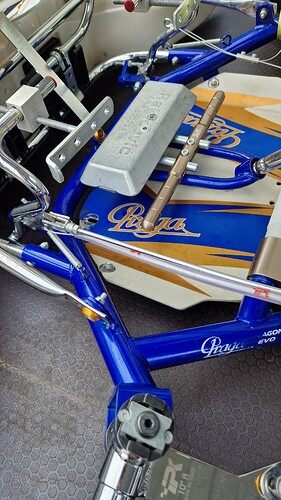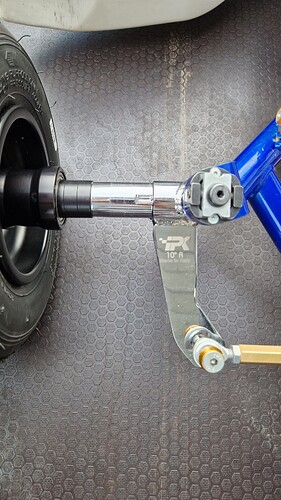Hi. I couldent seem to find a topic about this. What can it do what are the benefits of low and high and the downside. Im thinking about going lower im on the stock hight rn
The lowest you go, the freer you’ll feel the kart and the opposite to the high - as you go up, the more grip you’ll feel and have. That is why when raining you need to go as high as possible.
Shifters usually will always be mid/low for traction purposes.
Go to the high position if the track is green/lacking grip…
Soo if i go low like so the chassis is closer to the ground i will have more grip. And if its raining i go so that the chassi is so off the ground ass possible?
I believe a few people have actually suggested the opposite too interestingly. Musgrave and Abbasse if I’m not mistaken
I think the point of height in the wet is more jacking.
What problem are you trying to solve?
The confusion on more/less grip I think comes from the fact that we often conflate grip with load transfer in karting.
Example: Narrowing the rear actually decreases grip by increasing load transfer. The change in load transfer allows the inside wheel to pickup easier. Because of that, the observation that’s made is that it increases grip, when in fact it does not, it just “feels” like it does in the seat because you are feeling that load transfer.
Of course, it’s a balance because in a kart we need to reduce binding on the rear. But still, increasing load transfer does not give more grip.
When it comes to ride height it’s a similar thing. Raising ride height increases load transfer, lowering it will decrease load transfer. Use that as a guide on the direction you want to go. Keep in mind that changing ride height at one end also changes the rake which is the front to rear balance.
Essentially if you’re looking to change ride height, going lower on ride height is similar to going wider on the rear track… again though the ride height will change the rake too.
As James said, ride height doesn’t change grip. In fact most adjustments don’t change grip.
What you’re doing is changing weight-jacking or chassis flex. Higher rear ride height is like raising the seat; adds weight transfer. That can help the outside tire bite more.
But you have to keep an eye on where you are in the tuning window. If you already are overworking the outside rear tire, trying to force it to work harder might actually make it slide. So one adjustment can have two very different outcomes if you are diagnosing the handling problem wrong.
It all depends on what problem you’re trying to fix. Tuning without aiming to fix something isn’t tuning; it’s playing around.
My rear wheel isnt going of the ground when i turn causing me to not hit the apex right and getting a bad exit
And i have the rear so that the tires end exactly where the bumper ends
Raising rear ride height will help the inside rear lift. But it’s a large change. I would try smaller adjustments first like adding caster, widening front track, narrowing rear track, or stiffening front bar.
You need to take a measurement of that rear width.
Yeah just looking at where it compares to the bumper isn’t much help. Bumpers can be different widths.
Assuming end of the bumper tends to be around 1360mm.ish, i’m guessing this is for a wet setup. Perhaps tell us what kart, hub lengths, front width, camber, caster, toe and a solution can be found that is a simpler or less drastic change than ride height.
Ok soo i have a praga dragon evo chassi with x30 junior.
now i have aluminuim hubs front and back bc its starting to get cold outside.
how do i messure front width, and back witdh, back i figure is from the end of hub to the end of other hub. and front width is it from spindel to the outside of hub?
I don’t think most people measure overall front width, they just reference how many spacers are on the spindle.
For rear width just stick a tape measure through the axle with the wheels on and measure the width from the outside of the wheel to the outside of the other wheel.
As TJ just mentioned, use a straight edge against the outside of the rear wheel, put a tape measure through the axle from the other side and set your track width to the chassis setup recommended by Praga dry setting. A second person holding the straight edge is needed but I use a wood working clamp on the tire so I can do it alone. Your class will have a minimum and maximum track width when racing. I’d set it to the factory settings and narrow it if necessary to increase jacking. Your weight, seat height, caster and front track and torsion bar will all have an effect on your rear grip/bite. Going to neutral on ride heights and track and adjustments from there is the best bet. Messing with settings Willy Nilly without having a baseline will leave you completely out of whack on your set up. Each change should have a specific problem you’re trying to address.
i have 2,5 spacers on front and i have 136 width on the back i have a plastic torision bar that is from plastic and its round,
i cant seem to find any base line recomemded setup for praga do you have any clue where i can find thees
136cm is really narrow for the rear. But if you aren’t getting it to lift at that narrow, you might need to check your seating position and weight distribution, or you might need a bigger change like a different axle.
Here’s a Praga setup guide: http://www.stjerneracing.dk/img/cms/IPK_KART_SETUP_2017_REV001_20161130.pdf


